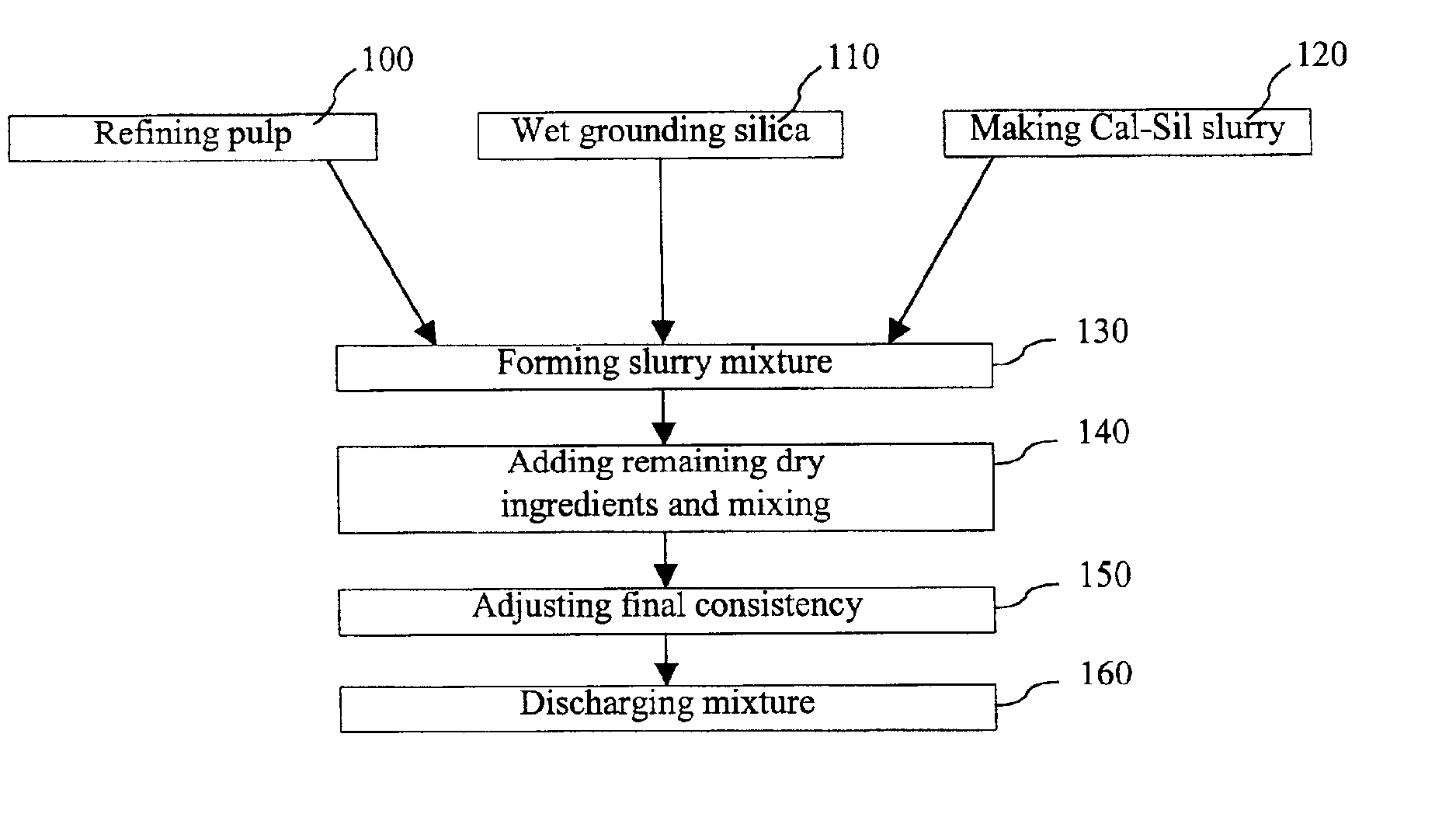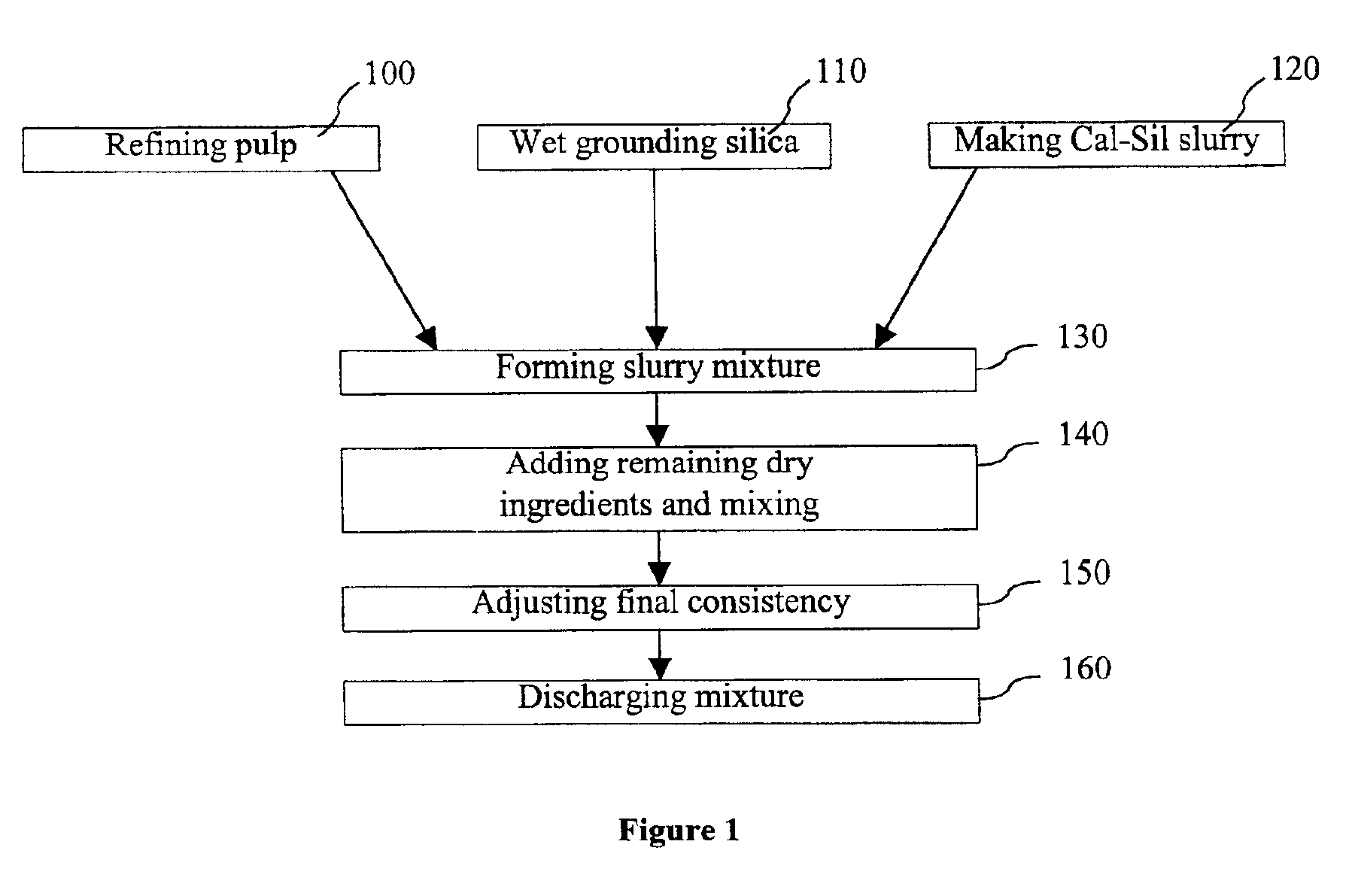Low density accelerant and strength enhancing additive for cementitious products and methods of using same
- Summary
- Abstract
- Description
- Claims
- Application Information
AI Technical Summary
Benefits of technology
Problems solved by technology
Method used
Image
Examples
example 1
Preparing Low-Density CSH.
[0048]Process lime water is weighed into the batch tank at a ratio of 6.0 L water per kg of lime (CaO) in the batch. It should be noted that the present example process is suitable for use with both fresh town water or process water. The water is discharged into the mixing tank and then heated with steam to about 65° C. The steam adds extra water. A 1300 kg batch of raw materials requires about 628 kg of lime which is slaked in about 3767 L of lime water and about 672 kg dry weight of ground quartz sand in a slurry at about 40% solids which is added to the slaked lime in a stirred tank.
[0049]The ground quartz sand is prepared as follows. Quartz sand is ground in a vertical stirred ball mill to a particle size such that 90% of the volume of the silica has a diameter of less than about 11.6 microns as measured by a Malvern “Mastersizer” laser diffraction particle size analyzer.
[0050]The slurry is mixed for about 15 minutes then pumped into the stirred pressur...
example 2
Preparing Low-Density CSH with Milled Silica
[0051]The example below describes the conversion of lime and ground quartz silica into low-density CSH of predominantly the tobermorite phase with a reaction time of only about 2 hours with no greater than about 10% unreacted silica.
[0052]Silica sand of average particle size between 0.3 and 0.5 mm is ground in a vertical stirred ball mill to a particle size of about D[90]=8.84 μm. D[90] represents the particle diameter that 90% weight of silica is less than, as measured by a Malvern “Mastersizer” particle size analyzer.
[0053]The lime and milled silica are then mixed into an aqueous slurry in a stirred pressure vessel. The molar ratio of lime to silica is about 1:1. Water is added to give a dry solids concentration of 4%±1%. The reaction is heated from ambient to 170±5° C. in about 40 minutes with a steam pressure of 750±50 kPa. The stirred pressure vessel is maintained under these conditions for about 2 hours.
[0054]Properties of the calciu...
example 3
Accelerated Cure of Green Fiber Cement Pastes
[0058]Three fiber cement pastes of equal dry density (about 0.85 g / cm3) were formed from ordinary Portland cement (OPC Type I, TXI), 200-mesh, ground silica, refined cellulose fiber (bleached kraft pulp, Weyerhaeuser), water, and a low-density additive. The low density additive—hollow ceramic microspheres and / or dry, low-density CSH (Micro-cel E®, World Minerals, Lompoc, Calif.)—was added to achieve the target density. To prepare the paste, 300 grams of the dry components proportioned according to TABLE 6 were mixed together in an Eirich R-02 high-shear mixer for about 3 minutes. Water was added to the mixture to form a paste, and the mixture was mixed for an additional 2 minutes. The paste was transferred to a Hobart-type mixer and kneaded for 2 to 3 minutes to further homogenize the paste. A sample of each paste was placed in a 200-mL plastic bottle and an RTD thermocouple was inserted in the mixture. The container was sealed and placed...
PUM
| Property | Measurement | Unit |
|---|---|---|
| Fraction | aaaaa | aaaaa |
| Fraction | aaaaa | aaaaa |
| Fraction | aaaaa | aaaaa |
Abstract
Description
Claims
Application Information
 Login to View More
Login to View More - R&D
- Intellectual Property
- Life Sciences
- Materials
- Tech Scout
- Unparalleled Data Quality
- Higher Quality Content
- 60% Fewer Hallucinations
Browse by: Latest US Patents, China's latest patents, Technical Efficacy Thesaurus, Application Domain, Technology Topic, Popular Technical Reports.
© 2025 PatSnap. All rights reserved.Legal|Privacy policy|Modern Slavery Act Transparency Statement|Sitemap|About US| Contact US: help@patsnap.com



